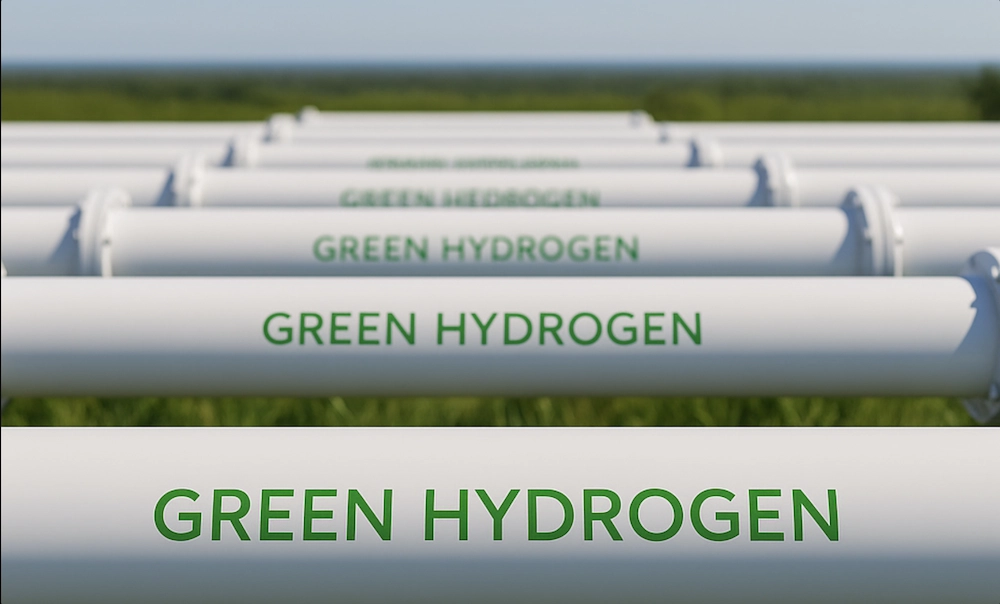
Ability
h01
Industry
h02
Energy
h03
Hydrogen has always been around us. For decades, industry has used it as an essential raw material in refineries, ammonia production, and metallurgical processes. However, this traditional hydrogen—known as gray hydrogen—emerges from processes that release large amounts of CO₂ into the atmosphere, specifically natural gas reforming or coal gasification.
Green hydrogen radically breaks with this paradigm. Through the electrolysis of water powered exclusively by renewable electricity, we separate H₂O molecules to obtain hydrogen with no associated emissions. The process is as clean as it is simple: water and renewable electricity go in, and pure hydrogen and oxygen come out. There are no emissions, no toxic waste, and no climate impact.
The difference isn't cosmetic: every kilogram of green hydrogen we produce avoids the emission of approximately 10 kilograms of CO₂ that its gray equivalent would generate. Multiplied by thousands of tons, the positive climate impact is monumental.
If there's one place in Europe destined to lead the way in green hydrogen production, it's Spain. Our country enjoys exceptional conditions that constitute a structural competitive advantage.
Spain has one of the most abundant renewable resources in Europe, with solar and wind potential that allows for the generation of clean electricity at increasingly competitive costs. This abundance of renewable resources translates directly into more affordable green hydrogen, as electricity represents the main component of its cost.
Furthermore, our geography offers something equally valuable: space. Industrial-scale green hydrogen projects require large areas. Spain has this space without the land-use conflicts that limit development in other, more densely populated European regions.
Green hydrogen has generated enormous expectations, some justified and others perhaps exaggerated. At Reolum, we have taken a pragmatic approach, identifying applications where green hydrogen can have an immediate impact.
In our vision, hydrogen is not a final product for export—it's a strategic component that we transform into e-methanol. Methanol solves the two major challenges facing hydrogen: the difficulty and cost of its storage and transportation. As a liquid at room temperature, e-methanol "packages" hydrogen into a stable molecule that can utilize existing infrastructure.
However, the true potential of green hydrogen goes beyond its direct use. In an energy system increasingly dominated by intermittent renewables, hydrogen is emerging as the perfect complement to manage the challenges of variability. Electrolyzers can be activated when there is a surplus of renewable generation, functioning as regulators of the electrical system and transforming what would be wasted energy into a valuable energy source.
The green hydrogen revolution not only transforms energy systems—it also revitalizes local economies where it is implemented. In regions like León, historically dependent on declining industries like coal mining, our green hydrogen projects represent much more than a technological alternative: they constitute a new horizon for development.
Green hydrogen projects generate skilled and stable employment, from the construction phase to operation. These are not temporary jobs, but rather positions that require technical qualifications and offer professional development opportunities in a forward-looking industry.
Beyond direct employment, the green hydrogen ecosystem creates new value chains and opportunities for economic diversification. From specialized equipment maintenance to engineering and logistics services, each green hydrogen project acts as the seed of a new industrial fabric.
At Reolum, we don't conceive our plants as industrial islands isolated from their surroundings. Rather, we design them as hubs of integrated industrial ecosystems where green hydrogen serves as a catalyst for innovative industrial symbioses, maximizing the added value that remains within the local environment.
Green hydrogen has completed its journey from laboratories to the first commercial demonstrations. Now the real race begins: large-scale industrial deployment.
The next few years will be crucial. Those who succeed in implementing viable industrial projects first will set the technological standards and capture the best opportunities in a rapidly expanding market.
At Reolum, we're not just participating in this race—we aspire to lead it. Our projects under development will not only produce green hydrogen, but will also demonstrate its optimal integration into complex value chains, creating a replicable model that can be expanded both in Spain and internationally.
When the world looks for examples of successful implementation of green hydrogen integrated into circular industrial solutions, it will look to Spain. And when Spain looks for pioneers in this field, it will find Reolum, transforming the potential of renewable energy into the fuel that will power the next industrial revolution.
